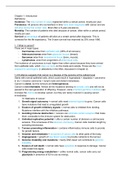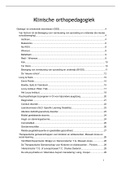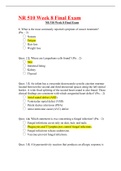Chapter 1: Introduction
Definitions:
Incidence: The new number of cases registered within a certain period, mostly per year.
Prevalence: All persons who somewhere in time have been diagnosed with cancer and are
still alive during that certain date. Most often a 5-year prevalence.
Mortality: The number of patients who died because of cancer, often within a certain period,
mostly per year.
Survival: a percentage of patients still alive at a certain period after diagnosis. This is
corrected for the life expectancy. The 5-year survival has improved by 30% since 1980.
1.1 What is cancer?
There are 4 major types:
- Carcinomas arise from epithelial cells (85% of all cancers).
- Adenocarcinomas arise from glandular tissues (breast).
- Sarcomas arise from mesodermal tissue (bone, muscle).
- Lymphomas, arise from progenitors of white blood cells.
The incidence of carcinomas is much higher than other cancer because they have arrived
from epithelial cells, which align our body on the inside and outside. Those are the most
exposed to carcinogens (= alterations in the DNA, discussed in Chapter 2).
1.2 Evidence suggests that cancer is a disease of the genome at the cellular level
Starts with normal epithelial cells, which could result in hyperplasia > dysplasia > carcinoma
in stu > invasive carcinoma > lymph node and distant metastases.
Cancer is clonal, but the tumours are heterogeneous.
Cancer is not inheritable. Almost all the mutations develop in somatic cells and will not be
passed to the next generation of offspring. However, some inherited germline mutations can
increase the chance to develop cancer, but they are rarely involved in causing cancer
immediately.
10 Hallmarks of cancer:
1. Growth signal autonomy = normal cells need external signals to grow. Cancer cells
have mutations that lead to unregulated growth
2. Evasion of growth inhibitory signals = normal cells is inhibited from dividing.
Mutations interfere with the inhibitory pathways.
3. Avoiding immune destruction = cancers can eliminate certain receptors that make
them vulnerable to the immune system for destruction.
4. Unlimited replicative potential = after a certain number of divisions a cell become
senesce. This is because of the telomere shortening. Cancer cells maintain length by
activating telomerase.
5. Tumour-promoting inflammation = contains inflammatory immune cells to provide
for growth factors.
6. Invasion and metastasis = movement of cancer cells to other parts of the body.
7. Angiogenesis = growth of new blood vessels to provide nutrients to the tumour.
8. Genome instability and mutations = faulty DNA repair can contribute to genomic
instability.
9. Evasion of cell death = normal cells have apoptosis in response to damage. Cancer
cells evade this signal.
10. Programming energy metabolism = unlike normal cells, cancer cells carry out
glycolysis in presence of O2 to use as energy.
, Growth, apoptosis, and differentiation regulate cell numbers:
The growth of a tumour is a disturbed balance between proliferation, cell death and
differentiation.
In leukaemias the differentiation process is disturbed, resulting in higher numbers of
undifferentiated cells. Normal genes can be activated and can become oncogenes, which is
a dominant effect. If tumour suppressor genes become inactivated, it could lead to cell
proliferation. This is a recessive event. How can an oncogene be identified in a lab? When
looking under the microscope, one can see multiple things:
- Different morphology
- Low serum culture to grow on
- No/decreased contact inhibition
- Cells can grow without a substrate for attachment
How does one do this? First, the gene is isolated from the tumour cell. Then that gene is
transferred to immortalized primary cells. Afterwards, one could evaluate if the transferred
cells obtain altered growth.
1.3 Influential factors in human carcinogenesis
- Environment: Sunlight (UVB) causes pyrimidine dimers and asbestos.
- Reproductive life: Contraception and hormone replacement therapy.
- Diet and exercise
- Alcohol: Head and neck cancer
- Smoking: >80% carcinogens, 40% of all cancer deaths.
- Own metabolism: DNA replication errors (chapter 2)
1.4 Principles of conventional cancer therapies
Cytostatic effect = Prevention of cell division
Cytotoxic effect = Killing of cancer cells
Therapeutic window = difference in maximum tolerating dose (MTD) and minimum dose
needed to extent anti-cancer activity.
Targeted drugs are more favourable. The limitation is that not everyone has the same
mutations, which makes it more important to diagnose based on mutations. Also, tumours
are heterogenous as explained before, which makes it also harder that not every tumour cell
has the same mutation > cannot target the total tumour.
, Chapter 2: DNA structure and stability: mutations versus repair
2.1 Gene structure - two parts of a gene: the regulatory region and the coding region
DNA consists of nucleotides, which are made of a sugar, phosphate and a nitrogenous base
(adenine, guanine, cytosine or thymine). A gene consists of 2 functional parts, a promotor
region and a coding region. This coding region is only a small part of the genome.
2.2 Mutations
Small changes in the DNA consist of:
- Base-pair substitutions = the change of a base pair into another one. This can
change the amino acid or could result in a stop codon if the base-pair substitution is
present in the protein-coding region. Not all DNA changes are oncogenic. Can be a
purine into another purine (A&G, 2 ring structures) or a pyrimidine into another
pyrimidine (T&C).
- Small deletions or insertions = an extra or deletion of amino acid. This can result in
a change in the reading frame: premature stop codon > truncated protein (non-
functional).
- Single and double-strand breaks = risk for deletions and large chromosome
rearrangements.
Large changes in the DNA consist of:
- Change in DNA content per nucleus.
- Chromosomal rearrangements = the gain or loss of a part of the chromosome. In a
risk of end-joining which gives problems in the cell division. Seen with the technique
of spectral karyotype (SKY).
- Gene amplification or deletions.
Mutations occurring in the promotor region may alter the regulation of a gene. This could
result in an over-/under expression of such a protein or the appearance of such protein at
the wrong time or location.
Mutations occurring in the coding region of a gene may affect the structure of a protein, and
thus the function of the gene products or cause truncation.
2.3 Carcinogenic agents
Can be exogenous or endogenous:
Exogenous:
- Smoking > polycyclic aromatic hydrocarbons (PAHs), can cause bulky adducts,
which are a covalent attachment of the chemical to the DNA.
- Drinking > alcohol
- Sun: UV
- Radiation
Endogenous:
- DNA replication mistakes or Reactive oxygen species (ROS)
Each agent has its own mutation spectrum. An example is pyrimidine C>T in UV.
Radiation as a carcinogen:
Ionizing radiation = high frequency electromagnetic radiation. This is also called
electromagnetic radiation. Examples are X-rays (induce double-strand breaks) and Y-ray. It
is the ionization of an atom causing the emission of an electron. The electron can damage
DNA cells indirect or directly. The indirect action is the making of a ROS with an electron, for
example, OH·. The direct effect is the electron damaging the DNA.









